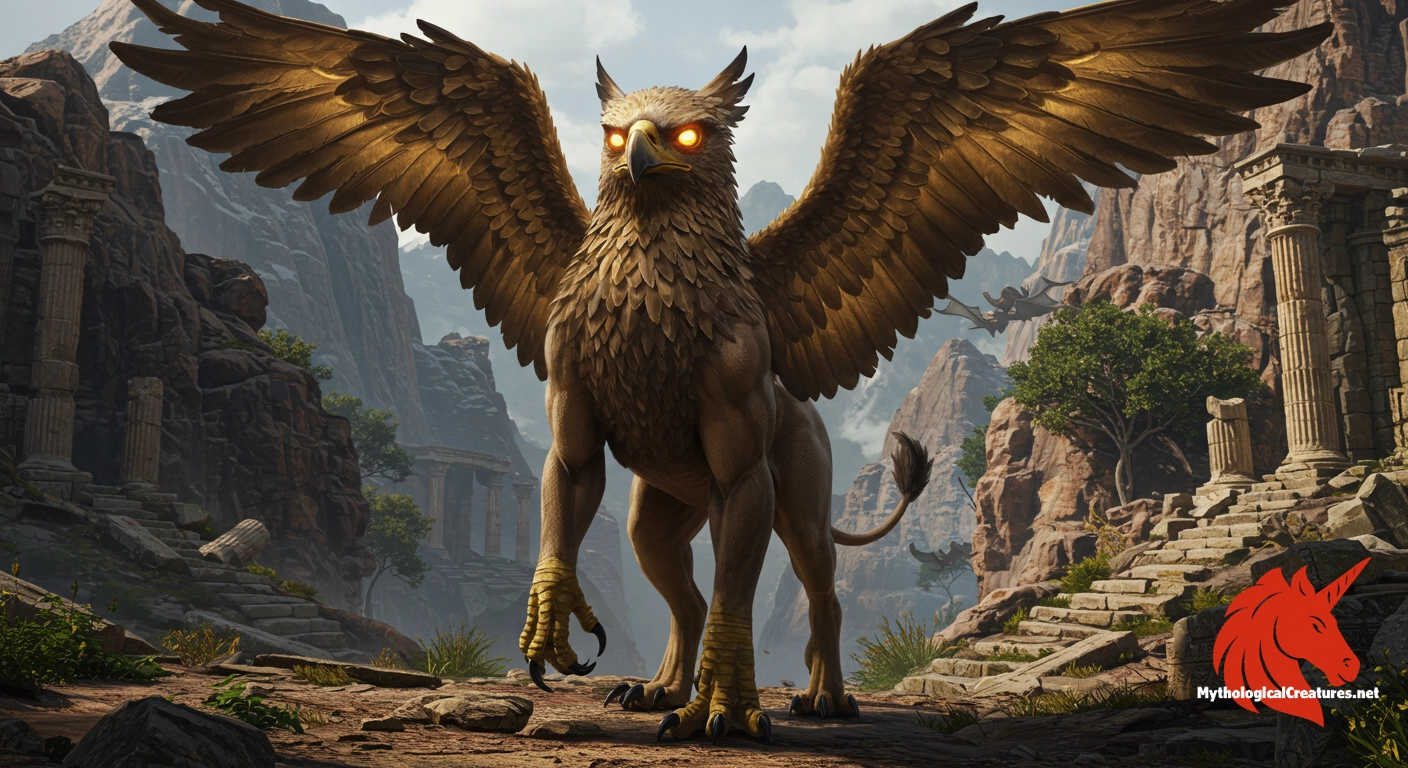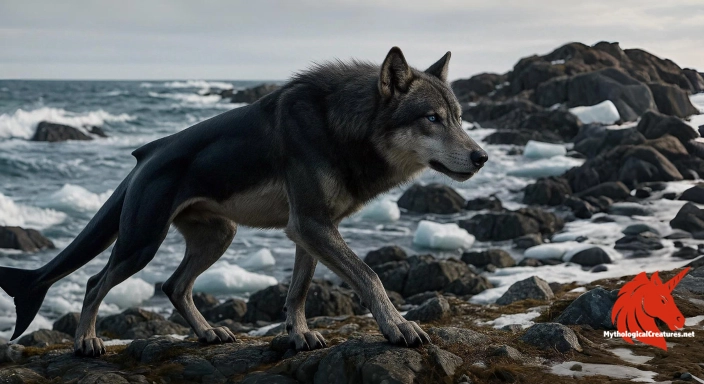Griffin: The griffin is a legendary hybrid creature with the body of a lion and the head and wings of an eagle.

Griffin
Griffin - Represents power, vigilance, and the fusion of terrestrial and aerial prowess
Origins & First Encounters
The griffin is a captivating mythological creature that merges the regal qualities of two of nature’s most formidable animals. It was first attested in the artistic traditions of ancient Greece and Persia, where its depiction as a noble guardian intrigued early observers. Emerging from a cultural crossroads, this creature became emblematic of divine power and stormed the imaginations of countless peoples. Its form, combining the head and wings of an eagle with the robust body of a lion, symbolises a balance between swift intelligence and brute strength. Early storytellers celebrated the griffin as a protector of sacred treasures and a watchful sentinel over the divine. Its dual nature not only bridged the realms of sky and land but also served as a metaphor for the fusion of opposites in nature. Over time, the griffin became an enduring symbol in heraldry and art, representing valour, wisdom, and fortitude. Its legacy as a mythological icon continues to evolve, captivating modern audiences with its timeless charm and mystery.
Source Texts & Tale Variants
Ancient texts and artistic depictions offer a rich mosaic of visions for the griffin, with early Greek inscriptions and sculptures providing some of the first concrete images. Latin literature further enriched the lore, giving the creature names such as gryps and grypus that echoed through later medieval narratives. Diverse manuscripts have preserved varying accounts, each layer adding depth to the legend of this hybrid creature. Some versions recount the griffin as a benevolent guardian, while others detail its formidable nature as a keeper of hidden wealth and mystical secrets. Medieval heraldic traditions embraced the griffin as an emblem of chivalric might, often embellishing coats of arms with its distinctive silhouette. Eastern sources, including fragments of Persian art, introduce their own nuances, portraying the griffin with intricate embellishments and exotic motifs. Such variants reveal both a consistency in its symbolic strength and a flexibility that allowed different cultures to adapt the creature to their own narratives. This blend of sources underlines the griffin’s enduring appeal across time and geography.
Form & Powers
The griffin presents a striking amalgamation of attributes, merging the keen, piercing gaze and formidable beak of an eagle with the powerful, muscular body of a lion. Its head boasts sharp features, including an incisive eye and a curved bill, emblematic of predatory prowess. Expansive wings sprout from its shoulders, suggesting both the grace of flight and the raw force of nature. The lion’s torso, complete with a flowing mane and robust limbs, grounds the creature in the earthly domain with impressive strength. Intricate details in artistic renditions reveal textured feathers on its wings juxtaposed against a sleek, tawny hide. The forelimbs culminate in razor-like talons, a clear testament to its dual identity as a creature of both air and land. Variations in depictions sometimes present the griffin as a colossal guardian, while other portrayals lean towards a more refined, elegant form. Every element of its anatomy is carefully chosen to embody a harmonious blend of regality, agility, and power.
Regional Faces
The griffin’s image has undergone numerous adaptations across different cultures and regions, each adding distinct interpretations to its legend. In ancient Greece, it was celebrated as a divine guardian, its appearance often linked with the protection of royal treasures and sacred spaces. European medieval art refined its symbolism further, embedding the griffin in heraldic traditions that emphasised bravery and noble lineage. In the Near Eastern context, particularly within Persian artistic traditions, the creature was frequently adorned with intricate ornamental details that underscored its exotic and mysterious nature. Certain Eastern European traditions enriched the griffin myth by merging it with local folklore and legendary protectors. Islamic art also interpreted its form with subtle variations, sometimes blending the griffin with regional motifs to create a symbol of celestial watchfulness. Despite these differences, all regional adaptations celebrate a common core: the griffin as a unifier of sky and earth. These manifold representations highlight how cultures have reimagined the same creature to mirror local ideals and aesthetics, ensuring its perpetual relevance in myth and art. The regional adaptations continue to inspire a diverse range of artistic expressions that honor the griffin’s storied past.
Cultural Parallels
In cross-cultural mythology, the griffin stands as an archetype of hybridity, sharing thematic similarities with other legendary creatures that embody the fusion of disparate natural elements. It is often compared with the ancient Mesopotamian lamassu, which also combines human, animal, and avian features to serve as a guardian of monumental spaces. While the sphinx similarly captures the imagination with its enigmatic form, the griffin’s distinct pairing of lion and eagle symbols sets it apart in its representation of both earthly might and heavenly vision. In European heraldry, the griffin is juxtaposed with dragons and other fantastical beings, each symbolising unique aspects of strength and perseverance. This comparative analysis highlights a universal human tendency to amalgamate animal attributes into symbols that exceed natural boundaries. The detailed attributes of the griffin, in particular, resonate with myths that celebrate the harmonious blend of agility, power, and vigilance. Such parallels not only underline shared mythological themes but also offer insight into how differing cultures interpret the ideas of protection and nobility. Ultimately, the griffin’s composite nature serves as a bridge connecting a wide array of mythic narratives, thereby reinforcing its position as a timeless emblem in world folklore.
Legacy & Modern Evolution
The evolution of the griffin’s imagery reflects a dynamic dialogue between the past and the present, transitioning from ancient emblematic records to a contemporary icon. Its early portrayals as a fierce divine guardian laid the foundation for its later adoption in medieval heraldry, where it symbolised mastery, endurance, and heroic virtue. The creature’s image was widely used on manuscripts, architectural elements, and even coinage, each instance reinforcing its status as a symbol of protective strength. As the centuries advanced, the griffin continued to captivate loyalties, its representation undergoing subtle transformations to mirror evolving cultural values. Modern fantasy literature and cinema have revived its rich heritage, infusing new layers of imagination into its enduring form. Contemporary artists and designers often blend these historic elements with modern aesthetics, creating reinterpretations that are both innovative and steeped in tradition. The griffin’s journey through history mirrors humanity’s perpetual fascination with myth, power, and the natural world. Today, it stands as a potent emblem that transcends time, uniting the realms of ancient lore and modern creative expression. Its persistent allure not only honours a deep-seated mythological tradition but also inspires future generations to embrace the mystique of legendary symbols.
Interesting Fact
One fascinating aspect of the griffin is its cross-cultural presence, appearing in both ancient Greek lore and medieval European heraldry, thereby symbolising a bridge between different mythological traditions.
Quick Creature Info
Origin:
Associations:
Our Mythic Legendary Rating:

Also Sometimes Known As:
Habitat:
Supernatural Powers:
Physical Attributes:
Abilities:
Behavior:
Lore:
Related Creatures, Tales or Lore
References
Discover Another Mythical Legend You May Not Have Heard Of?
Uncover the mysteries of ancient folklore and expand your knowledge of legendary beings from cultures around the world.
Dare to Meet the Akhlut....
Mythical Disclaimer: The images and data on this site are derived from various historical and literary sources, but we have found that many myths often have multiple versions and interpretations across references, sometimes contradictory. As a result, these creature depictions are artistic interpretations—imaginative blends of folklore, legend, and a dash of AI guesswork. Because creature descriptions vary widely, our illustrations and accompanying information represent our best effort to honor mythology while bridging creative gaps. Enjoy these interpretations—just remember, we've done our best to respect the stories and validate available data, but in the realm of mythology, details often shift, imagination leads the way, and nothing is ever set in stone!
Curated by the Mythological Creatures Team (rev. May 2025)
